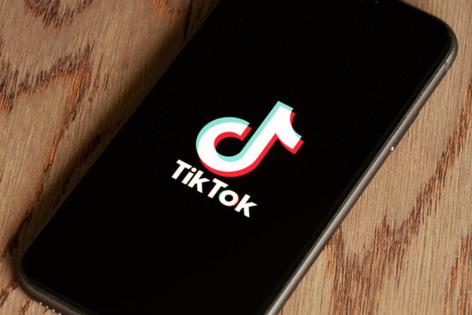Commentary: #SkinnyTok rebranded eating disorders dangerously fast
Published in Health & Fitness
#SkinnyTok is dead. Or at least that’s what TikTok wants you to believe after its recent ban of the hashtag promoting an extreme thin ideal. That might have appeased regulators, but it shouldn’t satisfy parents of teens on the app. An army of influencers is keeping the trend alive, putting vulnerable young people in harm’s way.
Today’s social media landscape makes it all too easy for creators to repackage and disguise disordered eating as a “healthy” part of everyday life. That lifestyle then gets monetized on various platforms — via habit trackers, group chats and 30-day aspirational challenges — and shared with a much broader audience.
The rise of #SkinnyTok is in many ways a rehashing of the pro-eating disorder content of the past. In the mid-1990s it was Kate Moss and “heroin chic.” Then came the Tumblr posts in the early aughts praising “Ana” and “Mia,” fictional characters that stood for anorexia and bulimia. Now, it’s 23-year-old influencer Liv Schmidt telling her followers to “eat wise, drop a size.”
Schmidt, a prominent #SkinnyTok influencer who is often credited with lopping the “y” off of “skinny” and replacing it with an “i,” is the founder of the members-only group “Skinni Société.” In September, she got banned from TikTok amid scrutiny by the Wall Street Journal.
The fact that she continues to make headlines some nine months later drives home the perpetual game of whack-a-mole that regulators are playing with problematic content. After her TikTok ban, Schmidt simply moved her audience over to Instagram, where her followers have grown from 67,000 to more than 320,000. Until recently, she was charging people $20 per month for a “motivational” group chat, but when The Cut found at least a dozen of those users were in high school, Meta demonetized her profile in May.
And yet her Instagram account still exists and she’s actively posting to her YouTube channel. A video titled “How to Create a Skinni Body on a Budget” raked in nearly 50,000 views within a week, a particularly disturbing level of engagement considering she’s encouraging her viewers to consume fewer than 1,000 calories a day — far less than what health officials recommend for a nutrient-dense meal.
In her Instagram bio, Schmidt links to a Google application where anyone can apply to her Skinni Société. While membership previously cost just $20 per month, screenshots posted on social media suggest this latest iteration could run about $2,900 per month — a gulf that proves her schtick is a complete black box. Regardless of price point, she continues to use public platforms to lure people into private spaces where conversations promoting disordered eating can flourish unchecked — all while profiting from them. Bloomberg Opinion made several attempts to reach out to Schmidt for comment, but she did not respond.
This sort of content is causing real harm. Johanna Kandel, founder and chief executive officer of the National Alliance for Eating Disorders said the uptick in callers mentioning #SkinnyTok to her organization’s hotline began last winter. And despite social media companies’ efforts to blunt the reach of the trend, as many as one in five calls fielded by the nonprofit in recent weeks have referenced the hashtag.
Some of those callers had past struggles with an eating disorder that was restarted by the hashtag, while others started following #SkinnyTok to “better themselves” or “get healthy” only to be pulled into a precarious mental space, Kandel says.
The bombardment of images of a skinny ideal can have even broader harms. Although this type of content has always lurked in the dark corners of the internet, people had to actively seek it out. Now, the algorithm delivers it on a platter.
That’s being served in insidious ways. While Schmidt’s rhetoric may leave little to the imagination, other influencers frame their content more subliminally. They encourage a disciplined lifestyle that blurs the lines of health consciousness and restrictive eating, which makes it all the more difficult to detect: Walk 15,000 steps a day, drink tea, nourish the body — these are things that might not raise alarm bells if a parent were to find them on their kid’s social feeds.
Sure, the TikTok trends that do raise alarm bells — remember “legging legs”? — are quick to get shut down. But what about something as seemingly innocuous as the popular “what I eat in a day” videos? How are social media companies expected to police troubling content that’s cloaked in euphemisms like “wellness” and “self-care”?
It’s a question that weighs on wellness and lifestyle creators who are trying their best to combat the negative content out there. When speaking with Kate Glavan, a 26-year-old influencer, it’s clear why she has been vocal about her experience with disordered eating: “I don’t know a single woman that hasn’t struggled with some sort of body image or food issue,” she said. “The only thing that snapped me out of my eating disorder was learning how it was destroying my health. I had a doctor look at my blood work and tell me I had the bone density of a 70-year-old woman at age 17.”
Whether that would work on today’s 17-year-olds is up for debate. “A lot of younger Gen Zers now believe that everything is rigged — schools, doctors, the government. That paranoia has created a distrust of expertise itself,” Glavan explained. “They think the whole medical system is corrupt, so they turn to influencers instead — which is incredibly dangerous.”
How dangerous? University of Toronto assistant professor Amanda Raffoul, who studies eating disorders, says there’s “a pretty solid body of evidence that the more young people in particular spent time online and on social media, the more likely they are to have poor body image, have negative thoughts about their appearance and to be engaging in harmful eating-related behaviors.”
For example, a 2023 review of 50 studies found that social media leads to peer comparisons and internalization of a “thin” ideal, which together contribute to body image anxiety, poor mental health and, for some, disordered eating. That effect is exacerbated when someone has certain risk factors — they are female or have a high BMI, for example — and are exposed to content that encourages eating disorders.
The danger is most acute in adolescent girls. That skinny ideal can elicit strong emotions and feelings of inadequacy at a time when they don’t yet have the tools to separate reality from fiction. But researchers also see a worrisome trend in adolescent boys who have been drawn in by fitfluencers pushing obsessive muscle training, unproven supplements and restrictive diets.
After a 2021 Wall Street Journal investigation revealed Meta was fully aware of Instagram’s potential to pull teen girls into a body image spiral, social media companies have offered some guardrails around problematic content. Kandel says when her nonprofit starts to hear multiple callers mentioning specific body image-related hashtags, it notifies companies, which typically are quick to shut them down.
While helpful, it also feels like the companies are doing the bare minimum to protect kids. Although eating disorder researchers can glean insights from individual social feeds, they still can’t get their hands on the internal data that could help them identify who is most at risk of harm and craft better safeguards.
For adolescents, the most powerful solution would be to step away from social media. Research shows spending less time scrolling can improve body image in struggling teens and young adults. But if that’s not realistic, parents and teachers could help them think more critically about what they’re seeing online — and how influencers like Schmidt make money by chipping away at their self-esteem.
If you or someone you know is struggling with disordered eating, the National Alliance for Eating Disorders can help: 1 (866) 662-1235
____
This column reflects the personal views of the author and does not necessarily reflect the opinion of the editorial board or Bloomberg LP and its owners.
Jessica Karl is a Bloomberg Opinion columnist and author of the Bloomberg Opinion Today newsletter.
Lisa Jarvis is a Bloomberg Opinion columnist covering biotech, health care and the pharmaceutical industry. Previously, she was executive editor of Chemical & Engineering News.
©2025 Bloomberg L.P. Visit bloomberg.com/opinion. Distributed by Tribune Content Agency, LLC.










Comments